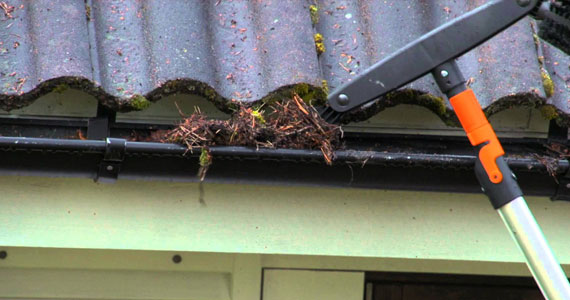The word “clog” is never used in a positive light. You never hear, “Your garden is just clogged with beautiful flowers!” or “The sky is clogged with sunshine today!” or “Your child has a lovely smile―clogged with white teeth!”
Drains get clogged. Arteries get clogged. Toilets get clogged. Your gutters get clogged. Unless we’re talking about wooden shoes from the ‘70’s, clog is definitely a 4-letter word!
Throughout the year, our homes are hit with a barrage of sticks, leaves, pine needles, and other debris, much of which ends up in your gutters and prevents water from draining as it should. Debris build-up can cause water to flow over the side of the gutter which can damage your siding, foundation, and landscape, or it can damage your gutters or cause ice dams to build up in the colder months.
The only way to prevent the damage is to regularly have your gutters cleaned which, if you’ve got trees around your house, should be done frequently. Or, you can take a more proactive approach to the problem and have gutter guards installed.
Gutter guards are designed to keep out the debris so your gutters can do their job and get water away from your home. They come in several different styles with varying levels of effectiveness.
Perforated Aluminum Guards―Aluminum sheets with small holes sit flat in your gutter. They’re ideal for leaves but the holes usually let a lot of pine needles in.
Solid Gutter Covers―These guards have a flat solid edge that hangs over the gutter. The smooth curved edge is designed so that water flows into the gutter and any leaves or debris falls to the ground. Needles can stick to the edge and clog things up so this kind of guard works best with leaves and sticks.
Micromesh Gutter Guards―Like the perforated aluminum gutters, these are installed on top of the gutter. These screens are made of a fine mess that keeps everything, including small debris like pine needles from clogging the gutters.
Foam Guards―Foam guards are lightweight foam tubes that sit in the gutter. Water can come in but debris cannot. They’re probably the easiest guards to install―simply cut them to size and place them in the gutter. The main problem with foam gutters is that the foam deteriorates quickly in the elements and once they begin to break down, they can clog your gutters themselves.
Brush Guards―Like foam guards, brush guards are tubes that are placed within the gutter but they look like long bottle brushes. What they gain in simplicity, they lose in effectiveness as leaves and needles tend to catch on the bristles and clog them.
Don’t choose a gutter guard based on its price or ease of installation. The best way to pick the right gutter guard is to examine the debris that accumulates in your gutters. Is it mostly leaves or do you have a lot of pine trees dropping needles or oak trees dumping tassels every year?
Lastly, even with gutter guards, it’s important to have your gutters cleaned periodically. Nothing keeps out pollen or silt which can build up over time. Installing guards on your gutters may not eliminate the word “clog” from your vocabulary but you shouldn’t have to use it when referring to your gutters!

